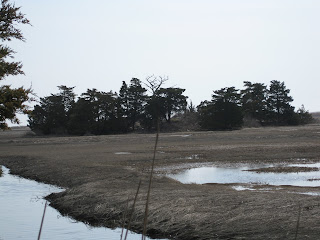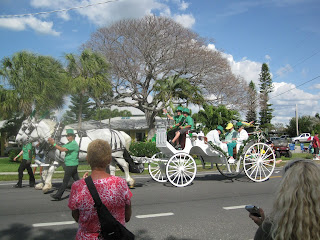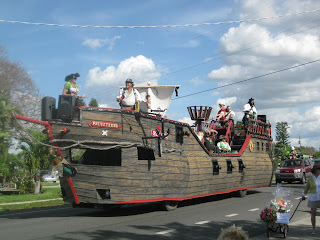New Jersey is the most densely populated state in the Union and has been since the 1970 census. The District of Columbia is much more densely packed, but it isn’t a state, and it doesn’t have hundreds of square miles of Pine Barrens.
The Barrens make up much of Burlington, Atlantic, and Ocean Counties. They cross the state almost from the Delaware in the west and come right down to the bayshore in the east at some places. The great thing about them is that they are downright spooky.
Nothing grows more than three stories high, because the soil won’t support it. The most common living thing down there is a fantastically twisted species of tree called the pitch pine. I love the place. It’s where the Jersey Devil was born and the Hindenburg blew up.
We left North Jersey a little before ten and less than two hours later, we were definitely someplace else. We traveled the Garden State Parkway for 70 miles or so and then took county roads to Warren Grove. A little south of there we stopped on top of a hill at place called Stafford Forge.
This used to be iron-making country but Stafford and all the other forges are long gone, just place names now. Stafford Forge is a preserve for a section of dwarf Pine Barrens known as the Plains.
This used to be iron-making country but Stafford and all the other forges are long gone, just place names now. Stafford Forge is a preserve for a section of dwarf Pine Barrens known as the Plains.
This is where regular people get to be the giants. It is a forest of mature trees that grow to be only about five feet high. There are several sections of it, and I don’t know how many square miles the Plains cover.
I read in an old botany book that the subsoil is so hard that the taproots can't break through it so the trees have to adjust their growth to limited nutrients and water.
Joanna stands about four eleven, and she was taller than most of the trees on top of the hill at Stafford Forge.
I’ve seen several parts of the Plains, and they are generally impassable because the pitch pines mix with oaks and, being short, their limbs lock close to the ground, so you can’t press your way through. You have to follow the trails cut by deer.
This section was an exception in my experience. It was almost exclusively pitch pine, and we could have picked our way through it for some distance, but chose not to. Tick season came early this year and there are Lyme disease warnings everywhere. The best time to go walking anywhere in the South Jersey woods is the wintertime after the first solid frost.
Next stop was an old cranberry farm called Whitesbog. According to a display in the general store, in its prime time, Whitesbog employed as many as 450 Italians—immigrants recruited in south Philadelphia.
The bogs are still there, and when Joanna saw them, they reminded her of fish farms in China that she had seen as a little girl.
The bogs are still there, and when Joanna saw them, they reminded her of fish farms in China that she had seen as a little girl.
It was also near here that the blueberry was domesticated. Or at least, the strain of it that we buy in boxes at the supermarket.
We strolled down some of the sand lanes in the woods. It was so quiet I could hear my tinnitus roar.
Then we drove to one of our favorite places, the Carranza Memorial near Tabernacle. Tabernacle is cool, too, because it’s where a Presbyterian minister named John Brainerd built a log church in the 1700s.
Captain Emilio Carranza was a Mexican flyer, the nephew of an assassinated president of Mexico. He had come to the United States on a goodwill tour. This was 1928, only 12 years after Pancho Villa raided New Mexico and Blackjack Pershing invaded Old Mexico. A year later, in 1917, some of the Kaiser’s men tried to convince Mexico to get even and invade the U.S.
Things could have been a mite rocky between us and our southern neighbor in those times.
Carranza was a celebrity—front page news—so when he crashed in the Pine Barrens, people were understandably upset. Every July, the Mount Holly chapter of the American Legion hosts a memorial service for Carranza at the crash site. The children of Mexico saved their money to pay for a monument that stands in a clearing of the woods in Wharton State Forest.
On the way in, we saw a turkey cross the road in front of us with that lurching dinosaur walk they have. On the way out, just around the same place, there was a rabbit trying the same thing, but it was too timid to make it across and turned tail.
We got to Batsto after the visitor center had closed. It has a few interesting exhibits about the environment and the old mill town.
Batsto was originally the plantation of a Swedish colonist named Eric Mullica. It later became an iron-working center. It supplied cannon balls to the Continental army and water pipes to Philadelphia. That business closed when the coal-fired furnaces of Pennsylvania opened up.
Being in the middle of the forest, a sawmill was a no-brainer. The mill still stands, but is not operational. There was a glass factory, but that is all gone. There's a sign to mark where it was. They made charcoal at Batsto, because that is what fueled the iron and glass furnaces. They may also have rendered turpentine.
The state has built replicas of workers' houses, and several of the original buildings are still standing, including the big house.
Batsto is in the Wharton State Forest. It is named for Joe Wharton, the financier whose name is on the Wharton business school at the U. of Pennsylvania. He bought thousands of acres of pinelands, including Batsto, because it all sits on top of one of the world's largest natural sweetwater reservoirs, the Cohansey Aquifer. He planned to sell the water to Philadelphia, but Trenton got wind of it and passed a law banning the sale of water to customers out of state.
So there was Wharton with all that ground and nothing to do with it. All the businesses at Batsto had long since gone under. He enlarged the manager's mansion and made it over in a style called Italianate, which was fashionable at the time.
He vacationed there from time to time and invited people to dinner.
The State of New Jersey bought it in the 1950s.
Joe’s Maplewood on the White Horse Pike (U.S. Route 30) in Hammonton is a great place to eat, by the way. Joanna had tilapia and vegetables. I had pork chops dressed with cheese, mushrooms, and all kinds of good stuff with pasta on the side.
Joanna had a Pepperwood pinot noir. She handed me the glass and said I should pay attention to how it finishes. It was tasty going in, but it changed completely when it was going down. It was downright spicy, and a lot of fun.
Batsto was originally the plantation of a Swedish colonist named Eric Mullica. It later became an iron-working center. It supplied cannon balls to the Continental army and water pipes to Philadelphia. That business closed when the coal-fired furnaces of Pennsylvania opened up.
Being in the middle of the forest, a sawmill was a no-brainer. The mill still stands, but is not operational. There was a glass factory, but that is all gone. There's a sign to mark where it was. They made charcoal at Batsto, because that is what fueled the iron and glass furnaces. They may also have rendered turpentine.
The state has built replicas of workers' houses, and several of the original buildings are still standing, including the big house.
Batsto is in the Wharton State Forest. It is named for Joe Wharton, the financier whose name is on the Wharton business school at the U. of Pennsylvania. He bought thousands of acres of pinelands, including Batsto, because it all sits on top of one of the world's largest natural sweetwater reservoirs, the Cohansey Aquifer. He planned to sell the water to Philadelphia, but Trenton got wind of it and passed a law banning the sale of water to customers out of state.
So there was Wharton with all that ground and nothing to do with it. All the businesses at Batsto had long since gone under. He enlarged the manager's mansion and made it over in a style called Italianate, which was fashionable at the time.
He vacationed there from time to time and invited people to dinner.
The State of New Jersey bought it in the 1950s.
Joe’s Maplewood on the White Horse Pike (U.S. Route 30) in Hammonton is a great place to eat, by the way. Joanna had tilapia and vegetables. I had pork chops dressed with cheese, mushrooms, and all kinds of good stuff with pasta on the side.
Joanna had a Pepperwood pinot noir. She handed me the glass and said I should pay attention to how it finishes. It was tasty going in, but it changed completely when it was going down. It was downright spicy, and a lot of fun.
The Howard Johnson motel was booked because—unbeknownst to me—this was the weekend of a motorcycle tour called the Pine Barrens 300. The nameless motel where we stayed let my reservations go and put me in a room called the Jacuzzi suite, which had no closet or coat rack, and a deep tub whose jets didn’t work. The manager gave me a break and only charged me time and a half what my original reservation would have cost.
We went back to the Carranza monument in the dark because that is absolutely Gothic. There are so many ghosts in this place, and to drive along a narrow road hemmed by spiky, hungry-looking trees is really worth the time.
We stayed for a few minutes and may have had the place to ourselves, although there could have been somebody parked in one of the clearings behind the monument.
By day, people park their horse trailers there when they come to ride the trails. It is supposed to be closed after dusk, so that's when kids go there.
There was a single planet shining through the clouds, but light enough to see by. The sky reflects the city glow from Philadelphia and Atlantic City, and the ground is white sand.
The deer were up and about. Along the same stretch where the turkey and rabbit were earlier in the day, three or four deer came out. We stopped to watch them. Good thing, too because, one casually wandered right in front of the car to cross the road.
We went back to the Carranza monument in the dark because that is absolutely Gothic. There are so many ghosts in this place, and to drive along a narrow road hemmed by spiky, hungry-looking trees is really worth the time.
We stayed for a few minutes and may have had the place to ourselves, although there could have been somebody parked in one of the clearings behind the monument.
By day, people park their horse trailers there when they come to ride the trails. It is supposed to be closed after dusk, so that's when kids go there.
There was a single planet shining through the clouds, but light enough to see by. The sky reflects the city glow from Philadelphia and Atlantic City, and the ground is white sand.
The deer were up and about. Along the same stretch where the turkey and rabbit were earlier in the day, three or four deer came out. We stopped to watch them. Good thing, too because, one casually wandered right in front of the car to cross the road.
Next morning, on the way to Leeds Point, we came across one hell of a surprise. We were following Atlantic County Road 561 and came to a fork where 575 breaks off. It creates a triangle of land, fenced in and covered with small American flags.
We turned around and came back. A couple of the markers identified the graves as belonging to men who had served in the “Col. Inf.” One died in 1909, another in the ’20s, so “Col.” can’t stand for “colonial.” Besides, General Washington’s soldiers were called Continentals.
Each grave had a Grand Army of the Republic marker in addition to a headstone. One of the stones spelled it out: “colored infantry.” These were black soldiers who had fought against the slaveholders. They had served separately and they had been buried separately.
Leeds Point is an interesting place to go because it the birthplace of the Jersey Devil. There is an interesting stone house there, and also an access road to a boat launch.
Smithville is a tourist attraction, but it’s fun. There are several restaurants there, including one that traces its pedigree back to colony days. Behind the big restaurant is a collection of shops they call Historic Smithville. It consists of buildings salvaged from all over the Barrens and reconstructed in a peddlers’ village.
There were also geese, swans, and a couple of roosters raising hell over a hen.
From Smithville, we took Route 9 to Port Republic. I’m not sure Port Republic exists anymore. It used to be a smugglers’ retreat and a stronghold for the New Jersey privateers, who attacked British merchant shipping during the Revolution. Big business. You sell the cargo at auction, sell the ship, sell the munitions to the Continental Army, and get to be a hero instead of a pirate.
Right off Route 9 in Tuckerton, where the Indian chief monument stands, is Seven Bridges Road. It’s not called that now. It’s more like Bay Boulevard, or something else sufficiently bland. Just before you come to the first big bridge, on the right, there is a place to pull over. That’s so you can get out of your car and peek through the cedars at the shell mound. The Lenape used to summer here and eat the shellfish. They threw the shells into one place, and over the course of centuries, maybe millennia, it has formed an artificial island large enough to support several trees.
You can take the road out to a beach on the Little Egg Harbor.
One last observation: The famous house with the chair on its cupola isn’t in Tuckerton, but in Eagleswood, N.J.






















